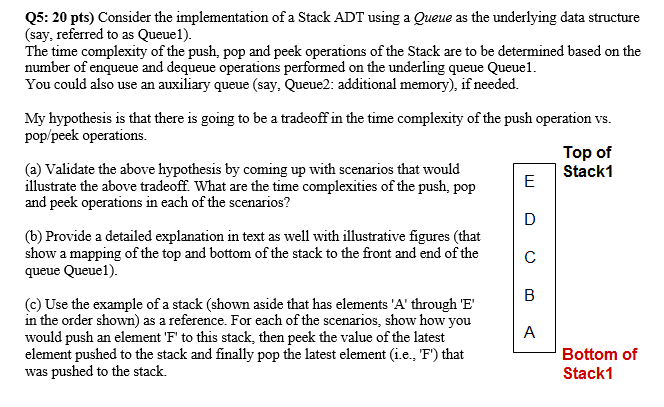Note: You should NOT write or use a computer program to answer any of these questions. If you do so, you will get ZERO for that question. 
Q5: 20 pts) Consider the implementation of a Stack ADT using a Queue as the underlying data structure (say, referred to as Queue1). The time complexity of the push, pop and peek operations of the Stack are to be determined based on the number of enqueue and dequeue operations performed on the underling queue Queue1. You could also use an auxiliary queue (say, Queue2: additional memory), if needed. My hypothesis is that there is going to be a tradeoff in the time complexity of the push operation vs. pop/peek operations. (a) Validate the above hypothesis by coming up with scenarios that would illustrate the above tradeoff. What are the time complexities of the push, pop and peek operations in each of the scenarios? (b) Provide a detailed explanation in text as well with illustrative figures (that show a mapping of the top and bottom of the stack to the front and end of the queue Queue1). (c) Use the example of a stack (shown aside that has elements 'A' through 'E' in the order shown) as a reference. For each of the scenarios, show how you would push an element ' F ' to this stack, then peek the value of the latest element pushed to the stack and finally pop the latest element (i.e., 'F') that was pushed to the stack. Q5: 20 pts) Consider the implementation of a Stack ADT using a Queue as the underlying data structure (say, referred to as Queue1). The time complexity of the push, pop and peek operations of the Stack are to be determined based on the number of enqueue and dequeue operations performed on the underling queue Queue1. You could also use an auxiliary queue (say, Queue2: additional memory), if needed. My hypothesis is that there is going to be a tradeoff in the time complexity of the push operation vs. pop/peek operations. (a) Validate the above hypothesis by coming up with scenarios that would illustrate the above tradeoff. What are the time complexities of the push, pop and peek operations in each of the scenarios? (b) Provide a detailed explanation in text as well with illustrative figures (that show a mapping of the top and bottom of the stack to the front and end of the queue Queue1). (c) Use the example of a stack (shown aside that has elements 'A' through 'E' in the order shown) as a reference. For each of the scenarios, show how you would push an element ' F ' to this stack, then peek the value of the latest element pushed to the stack and finally pop the latest element (i.e., 'F') that was pushed to the stack







